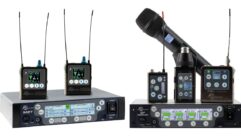
Technology Showcase: Wireless In-ear Monitoring Systems
Jul 1, 2008 12:00 PM,
By Bennett Liles
Today’s systems make performers masters of their own monitoring environments.

AKG IVM 4
In 1990, only the top names in musical entertainment could be seen using in-ear monitoring systems. But in the time since then, these devices have rapidly spread through the ranks — and now practically any pro or semi-pro vocalist or musician can afford them. The earlier version of personal monitoring took the recording studio design and simply moved it onstage with one or more headphone amplifiers snaking their outputs around the stage to each musician, but vocalists and other highly mobile performers had to stick to their floor wedges blasting the stage with acoustic power.
As the substantial advantages of in-ear monitoring systems won more converts, the wireless microphone companies took notice and developed lines of equipment built on their existing technology to reverse the wireless transmission process and send monitor mixes back to the performers. Improved sound quality and stereo imaging, elimination of feedback, and ultimate portability are just a few of the big steps up that were provided to performers — and it was clear by the mid-’90s that they weren’t going back.
FOH and monitoring technicians reaped the advantages of less bleed-over into adjacent mics and less mind-numbing feedback. The more recent addition of personal monitor mixers and digital audio networks carrying 16, 32, or more channels of uncompressed PCM audio into those in-ear monitors has made each performer the master of his or her own monitoring environment while freeing the tech to concentrate on equipment performance and FOH mixing. Here, we take a plunge into the world of in-ear monitoring systems and have a look at the workings and features.
THE FIELD
The AKG IVM 4 system consists of the SST 4 stereo transmitter, the SPR 4 body-pack receiver, one pair of IP 2 ear buds with three pairs of ear molds, a rod antenna, a rackmounting kit, power supply, batteries, and a 12-piece color-coding kit. The SST 4 transmits stereo sound on one of 1,200 channels between 500MHz and 860MHz. The SST4 also features an integrated compressor, a limiter, a high-pass filter, and a dedicated binaural room simulator. The rotary headphone volume control knob is combined with a push-push function for power on and off. The LC display shows all the setup parameters — including compressor and limiter gain reduction; menus for frequency, transmitter name, input gain, and audio processing; along with submenus for frequency group assignment, sub-channel, and RF output. There is also an input level bar graph and a red peak LED indicator. The rear panel has loop jacks for left and right audio channels that are connected in parallel with the audio in connectors. A 1/4in. TRS jack carries the processed stereo output sound. The SPR 4 body-pack receiver unit has a mini TRS jack for ear-bud connection and a rotary on/off switch and volume control for the ear buds, and it includes a permanently mounted receiver antenna and status LED. The battery compartment can accept either a pair of AA batteries or the optional rechargeable BP 4000 battery pack to be used with the CU 4000 charger.

Audio-Technica M3
The M3 wireless in-ear monitor system from Audio-Technica offers a choice of 1321 UHF channels shown on the backlit front panel LED display. Up to 16 M3 systems may be used simultaneously in pre-coordinated frequency groups. The MT3 stereo transmitter has versatile combination 1/4in./XLR input connectors on the rear panel along with XLR loop output connectors and attenuation switches. The front panel has a 1/4in. headphone output with volume control, and a selectable auxiliary input offers a connection point for an ambient microphone, click track, or other mic- or line-level input. The multilevel limiter serves to protect hearing and the pilot tone muting system works just like those on wireless microphones to prevent unwanted transmissions from entering the system when the transmitter is turned off. The double-conversion superheterodyne M3R stereo receiver can be operated in any of three modes including personal mix — in which the user can adjust the monitored mix, stereo, and mono modes. In personal-mix mode, the balance control can be rotated to the right to hear more band level and to the left to hear more vocal or instrument of choice in both ears. An advanced stereo setup using multiple audience microphones and aux outputs from the mixer can also be configured. The headphone output is 65mW at 32V, and the aux input connector is a 3.5mm TRS stereo phone jack. The unit can operate for up to eight hours on one pair of alkaline AA batteries.

Galaxy Audio AS-1000 Any Spot
The IMS 900 in-ear monitoring system from Beyerdynamic includes the SE 900 stereo transmitter, the TE 900 stereo receiver, a transmitter antenna, and DT 60 Pro earphones. In each 24MHz bandwidth, there are 16 pre-coordinated channels in which the transmitter can operate. The rear panel contains two audio-input combination balanced/unbalanced connectors, two 1/4in. loop outputs, a 50V BNC antenna connector, and the 12VDC power connector. The front panel features the central green LC display, separate left and right audio-input level meters, menu-navigation buttons, and power switch — along with headphone jack and volume control. The top LED on each meter is red and indicates clipping and distortion. There is also a rackmount kit with connections for a remotely mounted transmitter antenna. A balanced or unbalanced line level audio input signal can be applied to the XLR connectors and an unbalanced line level signal can go into the 6.35mm jack socket. The menu-navigation buttons can be used for setting the transmitter frequency, mono or stereo operation, transmitter name labeling, input sensitivity and the panel-control lock function. The TE 900 receiver has indicators for RF level and a left/right balance control, channel selector button, limiter switch, and a combination power switch and volume control.
Longtime monitor manufacturer Galaxy Audio markets the AS-1000 Any Spot wireless personal monitor to replace floor wedges and operate from the monitor out jack on a mixing console. The system has 64 selectable UHF frequencies, and the AS-1000T transmitter is selectable for either mono or stereo operation. The AS-1000R body-pack receiver operates on a diversity reception system with two antennas and has an auto-mute feature that senses any dropout and prevents any static from being heard by the user. Also intended as an assistive-listening system, the transmitter can send its signal to multiple receivers. The transmitter unit’s rear panel includes RCA, XLR, and 1/4in. input connections, and it offers simultaneous use of two sources with separate line- and mic-level controls on the front panel. The front also features a power button, a frequency display with group and channel selection knobs, a headphone jack with level-control knob, and an LED peak indicator. The system’s 64 channels range from 682MHz to 698MHz, and it exhibits a signal-to-noise ratio greater than 94dB at 15kHz deviation and 60dBuV antenna input. Audio frequency response to the headphone output is 100Hz to 10kHz ±3dB, and the line audio response is 40Hz to 15kHz ±3dB. The unit’s dynamic range is greater than 96dB, the headphone output level is 20mW, and the line stereo output level is -10dB. The receiver operates on two AA batteries or rechargeable batteries.
1
Technology Showcase: Wireless In-ear Monitoring Systems
Jul 1, 2008 12:00 PM,
By Bennett Liles
Today’s systems make performers masters of their own monitoring environments.

Hear Technologies Freedom Back
The Freedom Back wireless stereo in-ear system from Hear Technologies includes a transmitter, antenna, receiver, carrying case, and rackmount kit with an extension cable for mounting the antenna on the front panel. Available in UA and UB frequency bands, the system on UA band operates from 584MHz to 608MHz, while the B-band system operates from 655MHz to 679MHz with 120 channels per band. Up to 10 transmitters may be used in the same venue depending on local UHF conditions. On the front panel of the transmitter, the backlit LCD shows frequency, audio level, group, and channel. The front panel includes a 1/4in. stereo headphone jack with volume control, two menu-navigation buttons, a programming-set button, and a power button. On the rear panel is a jack for the DC power adapter, a stereo-mono selector switch, left and right audio inputs with combination 1/4in. TRS/XLR connectors, a 12dB attenuation pad switch, separate left and right channel audio input level controls, and a 50Ω antenna connector. The transmitter unit has a built-in automatic limiter, and a set of rack ears and an extension cable are included for front-mounting the antenna. The belt-pack receiver has a permanently mounted antenna, RF signal LED, 1/8in. stereo earphone jack, audio volume control and on/off knob, backlit LCD showing frequency, group, channel, battery indicator and mono/stereo operation. Also present are menu-navigation and program-set buttons.
The MI-808 wireless in-ear monitoring system from Mipro offers true diversity reception in 24MHz bandwidth on 16 selectable pre-programmed frequencies from 614MHz to 870MHz. The system delivers a signal-to-noise ratio of 90dB, and it can operate in either stereo or mono mode. The MI-808T transmitter is a 1/2RU unit in a metal case, and the front panel includes a power button, 1/4in. headphone jack with volume control, backlit LCD showing channel and frequency, and four menu-navigation buttons. The rear panel has two XLR-1/4in. combo audio-input connectors and two 1/4in. output jacks along with the antenna connector. Dynamic expander circuitry delivers a 90dB signal-to-noise ratio, and a built-in limiter prevents excessive audio levels to the user. The MI-808R receiver has an LCD showing frequency channel, and it uses an auto power saver. The unit uses two antennas for diversity reception, and it can operate up to 10 hours on two AA batteries.

Samson UHF EarAmp
The Nady Systems PEM-500 wireless personal in-ear monitor system provides 16 channels of UHF communication, and up to eight can be simultaneously used — depending on country and frequency band. The system consists of the PEM-500T transmitter and the PEM-500R receiver. Any number of receivers can be used with the same transmitter operating on a common UHF frequency. The transmitter uses a companding circuit to maximize dynamic range. The typical maximum range of operation is 300ft., and there is a foam-padded traveling case for protection. The transmitter is 1/2RU, and it can be mounted side by side with another transmitter using an optional rack kit. Along with the XLR line inputs, there is also a 1/4in. microphone input for directly cuing performers onstage. Controls also include a stereo-mono selector switch and an input-level volume control. Available channels can be stepped through with the channel-selector button until the desired channel is shown on the LCD front-panel display. Audio input levels may be adjusted while noting the level on the 10-segment LED ladder on the front panel. The input signal is monitored on the PEM-500T front-panel 1/4in. headphone jack, and the monitor level is adjusted with the monitor volume control. The PEM-500R receiver is powered by a single 9V battery, and the battery level is visible on the two-color, unit on/signal/low-battery LED. A small screwdriver adjust knob is used to select the proper frequency, and the stereo/mono switch is in the battery compartment.
The Samson UHF EarAmp system can operate in either stereo or dual mono 2-channel mode with individual channel volume controls and separate bass and treble controls to fine tune the monitoring audio frequency response. To protect the user’s ears from excessive volume levels, a built-in limiter is included. Operating frequency may be selected by group and channel or individually in 25kHz increments over a range from 774MHz to 864.5MHz. A receiver-programming function allows for frequency selection at the flip of a switch and push of a button. A country selection feature allows a choice among on the frequencies legal in the chosen country. The volume control is teamed with a center-detented channel balance control and 15dB attenuation pads along with a five-segment input level VU meter and a large, backlit LCD showing the selected country, group, channel, and frequency. There are also dual 1/4in. and 1/8in. headphone outputs with a level control. The unit also features a loudness button for greater intelligibility when monitoring at low volume levels. The receiver allows stereo and dual-channel mono operation, includes a 200mW, 1/8in. headphone connector, and operates up to 4 hours on a single 9V battery. When the battery voltage drops below 7V, the receiver’s battery condition LED illuminates. A built-in limiter helps protect hearing from excessive monitoring levels.

Sennheiser EW 300 IEM evolution Wireless G2
The EW 300 IEM evolution Wireless G2 monitoring system from Sennheiser is composed of the EW 300 IEM G2 rackmount transmitter and the EK 300 IEM G2 body-pack receiver. These units can share nine frequency banks with up to 12 compatible frequencies per bank, each of which can be immediately called up as a preset. When switched from stereo to dual-channel mono listening mode, the two independent channels may be balanced with separate volume controls to adjust the mix to favor the individual user’s voice or instrument source in the mix to varying degrees. The operational frequencies are in various bands from 518MHz to 866MHz for a total of 1,440 possible frequencies. The system’s audio frequency response is from 40kHz to 15kHz, and the HDX compander circuit extends dynamic range with a signal-to-noise ratio of 91dB. There is also a switchable pilot tone muting circuit to avoid getting noise in the monitor reception when the transmitter is turned off. The receiver has a scanning function that can scan the frequencies in one bank and can operate from 6 to 10 hours on one battery, depending on the volume setting used. The transmitter has an operating power level of 30mW into the 50V antenna. Optional accessories include the AC2 antenna combiner, AM2 antenna mount, a2003-UHF passive directional antenna, and the CC2 carrying case for the whole system.

Sensaphonics 3D Active Ambient
The 3D Active Ambient in-ear monitoring system from Sensaphonics provides a unique monitoring solution for the best of both worlds between ambient sound onstage and the isolation of in-ear monitoring with custom-fitted earpieces. This is accomplished through the use of tiny microphones inside the custom 3D ambient earphones that pick up ambient sound and send it into one channel of the body-pack receiver. The other channel provides the monitor mix sent from any model in a variety of third-party in-ear monitoring transmitters. The mix between the monitor signal and ambient sound can then be adjusted to suit the performer’s individual taste. The Model 3DAA for use with wireless IEM systems consists of the 3D-M body-pack mixer with a 1/8in. earpiece jack, custom-fit 3D ambient earphones, and IEM jumper cable. The Model 3DHW for use with hard-wired systems includes the 3D-L body-pack mixer using a Lemo earpiece connector, 3D-1 single driver or 3D-2 dual driver ambient earphones, and the dual XLR jumper cable. The 3D active ambient system earphones provide 26dB of broadband isolation from ambient noise. The clear silicone custom-fitted earphones contain tiny filters to provide smooth frequency response and keep debris out of the internal loudspeakers. The condenser microphones are designed to allow a natural ambient response and the binaural system provides natural sound directionality with no distortion up to 140dB SPL.
The Shure PSM 700 wireless personal-monitoring system includes the P7T transmitter and the P7R receiver, which can operate on any of 32 user-selectable UHF frequency channels for a maximum simultaneous use of up to 16 systems. The units can be operated in stereo or MixMode for individual control of the overall monitor mix and the user’s source audio with the volume and balance dials. For better clarity of audio, the receiver has a high-frequency boost function. Offering a choice of voltage between 120V and 230V, the transmitter has a peak transmission modulation limiter with fixed threshold and modulation indicators. Looping audio connectors on the P7T provide the capability to daisy-chain transmitters on one line, and tone-key squelch prevents noise from entering the receivers when the transmitter is turned off or the receiver loses the transmitter’s signal. The transmitter is 1/2RU, and mounting hardware is available to mount two of the units side by side in one rack space. The front panel includes an input level control, LED ladder audio level indicator, stereo/mono mode switch, 1/4in. and 1/8in. headphone jacks with volume control, channel selector, channel group switch, and power button.
MORE INFORMATION
AKG
www.akg.com
Audio-Technica
www.audio-technica.com
Beyerdynamic
www.beyerdynamic.com
Galaxy Audio
www.galaxyaudio.com
Hear Technologies
www.heartechnologies.com
Mipro
www.mipro.com.tw
Nady Systems
www.nadywireless.com
Samson
www.samsontech.com
Sennheiser
www.sennheiserusa.com
Sensaphonics
www.sensaphonics.com
Shure
www.shure.com
2










